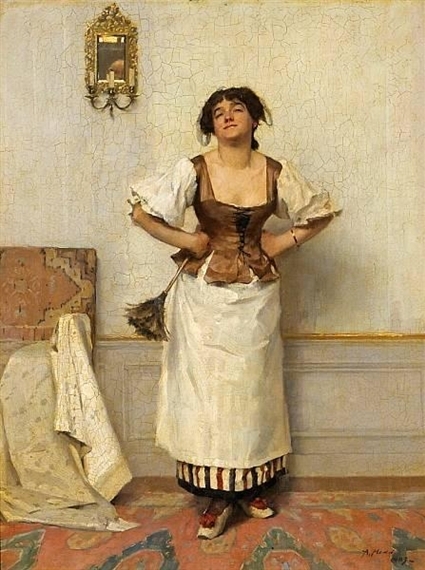|
Malla Höök
Amelie "Malla" Höök (1811–1882) was a Swedish actress and courtesan. She was engaged at the Royal Dramatic Theatre in Stockholm in 1828–1842, and also a well known courtesan. She is often mentioned in theater history for her friendship with Emilie Högqvist. Life Malla Höök's father is unknown. She was a student of the Royal Swedish Ballet in 1825–26, a member of the travelling Berggren theater in 1826–28, debuted at the Royal Dramatic theater in 1828, and was active there from 1829 until 1842. She was a personal friend of her colleague Emilie Högqvist, and often mentioned as such. As a stage artist, Malla Höök was described as a dutiful worker and a gifted soubrette actress. She was however more famed as a courtesan, and was for several years the mistress of a noble diplomat. In 1842, she ended her career at the age of 31, had herself declared of legal majority by royal petition (by the Civil Code of 1734, unmarried women were legal minors unless they petitioned ... [...More Info...] [...Related Items...] OR: [Wikipedia] [Google] [Baidu] |
Royal Dramatic Theatre
The Royal Dramatic Theatre (, colloquially ''Dramaten'') is Sweden's national stage for "spoken drama", founded in 1788. Around one thousand shows are put on annually on the theatre's five running stages. The theatre has been at its present location in the Art Nouveau building at Nybroplan, Stockholm, since 1908. The theatre was built by the architect Fredrik Lilljekvist. Famous artists like Carl Milles and Carl Larsson were involved in making the decorations, and some of the interior decorations were made by Prince Eugen. The theatre's acting school, the Royal Dramatic Training Academy, produced many actors and directors who would go on to be famous, including Gustaf Molander (who also taught there), Alf Sjöberg, Greta Garbo, Vera Schmiterlöw, Signe Hasso, Ingrid Bergman, Gunnar Björnstrand, Max von Sydow, and Bibi Andersson. The school was split off as a separate institution in 1967 (see Swedish National Academy of Mime and Acting). History 17th and 18th ce ... [...More Info...] [...Related Items...] OR: [Wikipedia] [Google] [Baidu] |
Royal Swedish Ballet
The Royal Swedish Ballet is one of the oldest ballet companies in Europe. Based in Stockholm, Sweden, Gustav III of Sweden, King Gustav III founded the ballet in 1773 as a part of his national cultural project in response to the French and Italian dominance in this field; he also founded the Royal Swedish Opera and the Royal Dramatic Theatre. All of these were initially located in the old theatre of Bollhuset. The troupe was founded with the opening of the Royal Swedish Opera, which has served as its home since that time. History In 1773, the cultural professions of acting, opera-singing and ballet-dancing in Sweden were all performed by foreign troupes. The first ballet performance was performed at the Swedish court when the French ballet troupe of Antoine de Beaulieu was hired at the court of Queen Christina of Sweden, Queen Christina in 1638, and the first Public ballet performance were performed by the foreign theatre troupes at the theatre of Bollhuset later the same centu ... [...More Info...] [...Related Items...] OR: [Wikipedia] [Google] [Baidu] |
Soubrette
A soubrette is a female minor stock character in opera and theatre, often a pert lady's maid. By extension, the term can refer generally to any saucy or flirtatious young woman. The term arrived in English from Provençal via French, and means "conceited" or "coy". Theatre In theatre, a soubrette is a comedy character who is vain and girlish, mischievous, lighthearted, coquettish and gossipy—often a chambermaid or confidante of the ingénue. She often displays a flirtatious or even sexually aggressive nature. The soubrette appeared in commedia dell'arte scenarios, often in the role of Columbina, where the actress would provide the details of her behaviour and dialogue. From there, she moved to the works of Molière, which were influenced by the Commedia; the role of Dorine in '' Tartuffe'' (1664) fits the description. A famous example, though a hundred years later, is Suzanne in Beaumarchais' '' Le Mariage de Figaro'' (1784). Opera In classical music and opera, the term ''s ... [...More Info...] [...Related Items...] OR: [Wikipedia] [Google] [Baidu] |
Legal Majority
The age of majority is the threshold of legal adulthood as recognized or declared in law. It is the moment when a person ceases to be considered a minor, and assumes legal control over their person, actions, and decisions, thus terminating the control and legal responsibilities of their parents or guardian over them. Most countries set the age of majority at 18, but some jurisdictions have a higher age and others lower. The word ''majority'' here refers to having greater years and being of full age as opposed to ''minority'', the state of being a minor. The law in a given jurisdiction may not actually use the term "age of majority". The term refers to a collection of laws bestowing the status of adulthood. Explanation The term ''age of majority'' can be confused with the similar concept of the ''age of license''. As a legal term, ''license'' means ''permission'', referring to a legally enforceable right or privilege. Thus, the age of license for a specific activity, eg the age ... [...More Info...] [...Related Items...] OR: [Wikipedia] [Google] [Baidu] |
Civil Code Of 1734
The Civil Code of 1734 ( Swedish: ''1734 års lag''), was a code of law passed by the Swedish Riksdag of the Estates in 1734, and put in effect after it had been ratified by Frederick I of Sweden 23 January 1736. It became the foundation of the later civil code in Sweden – and remained so in Finland when annexed by the Russian Empire in 1809; though many alterations have been made in both Sweden and Finland since. The current Swedish Code of Statutes is founded on the civil code of 1734. Context The Civil Code of 1734 replaced the previous ''Kristofers landslag'' ('The National Law of Christopher') passed by King Christopher of Bavaria in 1442, and the ''Stadslagen'' ('The City Law') from 1347–57. It was the first civil code to apply the same law to all of Sweden. Previously, the ''Kristofers landslag'' referred to the Medieval Scandinavian law concerning the countryside, which could vary depending on the county, or the ''Stadslagen'' concerning the cities.Nationalencykloped ... [...More Info...] [...Related Items...] OR: [Wikipedia] [Google] [Baidu] |
Drottningholm
Drottningholm, literally "Queen's Islet", is a locality situated in Ekerö Municipality, Stockholm County, Sweden, with 398 inhabitants in 2010. It is on the island Lovön in lake Mälaren on the outskirts of Stockholm. Drottningholm Palace, the residence of the Swedish royal family since 1981, is here. The village was planned and built in the mid-18th century for the people working at the palace. It is a good example of how a Swedish village would have looked like in the 18th and 19th centuries, containing many picturesque houses and villas. Drottningholm is accessible with public transport by taking the metro to Brommaplan, then an Ekerö-bound SL bus. Ships At least two ships have been named ''Drottningholm''. One is the former ferry that was built in 1909 and is now a listed historic ship of Sweden. Another was the transatlantic ocean liner RMS ''Virginian'', which Swedish American Line bought in 1920 and renamed . Among English speakers, the liner's unfortunate ... [...More Info...] [...Related Items...] OR: [Wikipedia] [Google] [Baidu] |
1811 Births
Events January–March * January 8 – An 1811 German Coast Uprising, unsuccessful slave revolt is led by Charles Deslondes, in St. Charles and St. James Parishes, Louisiana. * January 17 – Mexican War of Independence – Battle of Calderón Bridge: A heavily outnumbered Spanish force of 6,000 troops defeats nearly 100,000 Mexican revolutionaries. * January 22 – The Juan Bautista de las Casas, Casas Revolt begins in San Antonio, Spanish Texas. * February 5 – British Regency: George IV of the United Kingdom, George, Prince of Wales becomes prince regent, because of the perceived insanity of his father, King George III of the United Kingdom. * February 19 – Peninsular War – Battle of the Gebora: An outnumbered French force under Édouard Mortier, duc de Trévise, Édouard Mortier routs and nearly destroys the Spanish, near Badajoz, Spain. * March 1 – Citadel Massacre in Cairo: Egyptian ruler Muhammad Ali of Egypt, Muhammad Al ... [...More Info...] [...Related Items...] OR: [Wikipedia] [Google] [Baidu] |
1882 Deaths
Events January * January 2 ** The Standard Oil Trust (business), Trust is secretly created in the United States to control multiple corporations set up by John D. Rockefeller and his associates. ** Irish-born author Oscar Wilde arrives in New York at the beginning of a lecture tour of the United States and Canada. * January 5 – Charles J. Guiteau is found guilty of the assassination of James A. Garfield (President of the United States) and sentenced to death, despite an insanity defense raised by his lawyer. * January 12 – Holborn Viaduct power station in the City of London, the world's first coal-fired public electricity generating station, begins operation. February * February 3 – American showman P. T. Barnum acquires the elephant Jumbo from the London Zoo. March * March 2 – Roderick Maclean fails in an attempt to assassinate Queen Victoria, at Windsor, Berkshire, Windsor. * March 18 (March 6 Old Style) – The Principality of Serbia becomes ... [...More Info...] [...Related Items...] OR: [Wikipedia] [Google] [Baidu] |
19th-century Swedish Actresses
The 19th century began on 1 January 1801 (represented by the Roman numerals MDCCCI), and ended on 31 December 1900 (MCM). It was the 9th century of the 2nd millennium. It was characterized by vast social upheaval. Slavery was abolished in much of Europe and the Americas. The First Industrial Revolution, though it began in the late 18th century, expanded beyond its British homeland for the first time during the 19th century, particularly remaking the economies and societies of the Low Countries, France, the Rhineland, Northern Italy, and the Northeastern United States. A few decades later, the Second Industrial Revolution led to ever more massive urbanization and much higher levels of productivity, profit, and prosperity, a pattern that continued into the 20th century. The Catholic Church, in response to the growing influence and power of modernism, secularism and materialism, formed the First Vatican Council in the late 19th century to deal with such problems and confirm cer ... [...More Info...] [...Related Items...] OR: [Wikipedia] [Google] [Baidu] |
Swedish Stage Actresses
Swedish or ' may refer to: Anything from or related to Sweden, a country in Northern Europe. Or, specifically: * Swedish language, a North Germanic language spoken primarily in Sweden and Finland ** Swedish alphabet, the official alphabet used by the Swedish language * Swedish people or Swedes, persons with a Swedish ancestral or ethnic identity ** A national or citizen of Sweden, see demographics of Sweden ** Culture of Sweden * Swedish cuisine See also * * Swedish Church (other) * Swedish Institute (other) * Swedish invasion (other) * Swedish Open (other) Swedish Open is a tennis tournament. Swedish Open may also refer to: * Swedish Open (badminton) * Swedish Open (table tennis) * Swedish Open (squash) * Swedish Open (darts) {{disambiguation ... {{disambig Language and nationality disambiguation pages ... [...More Info...] [...Related Items...] OR: [Wikipedia] [Google] [Baidu] |





